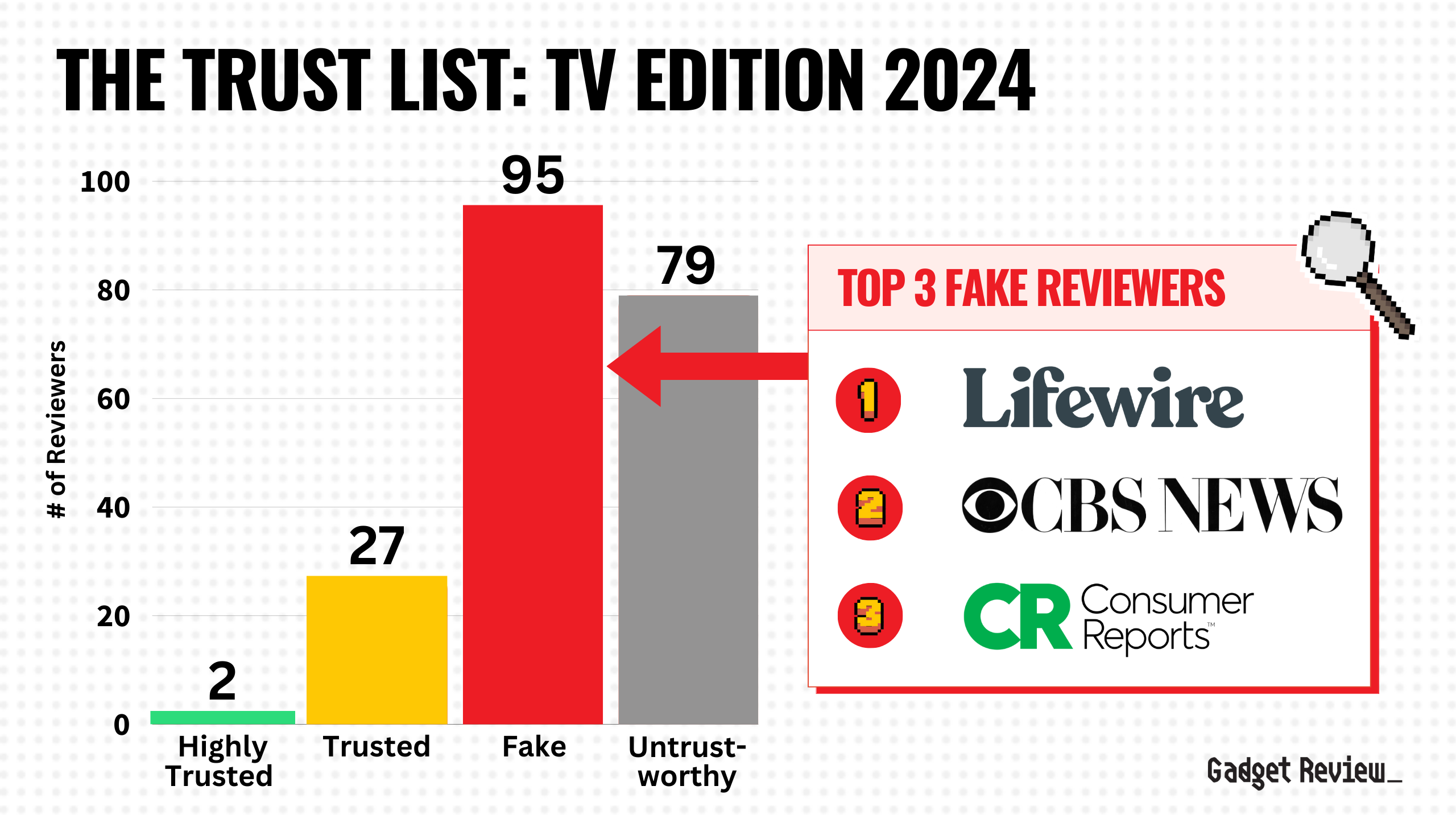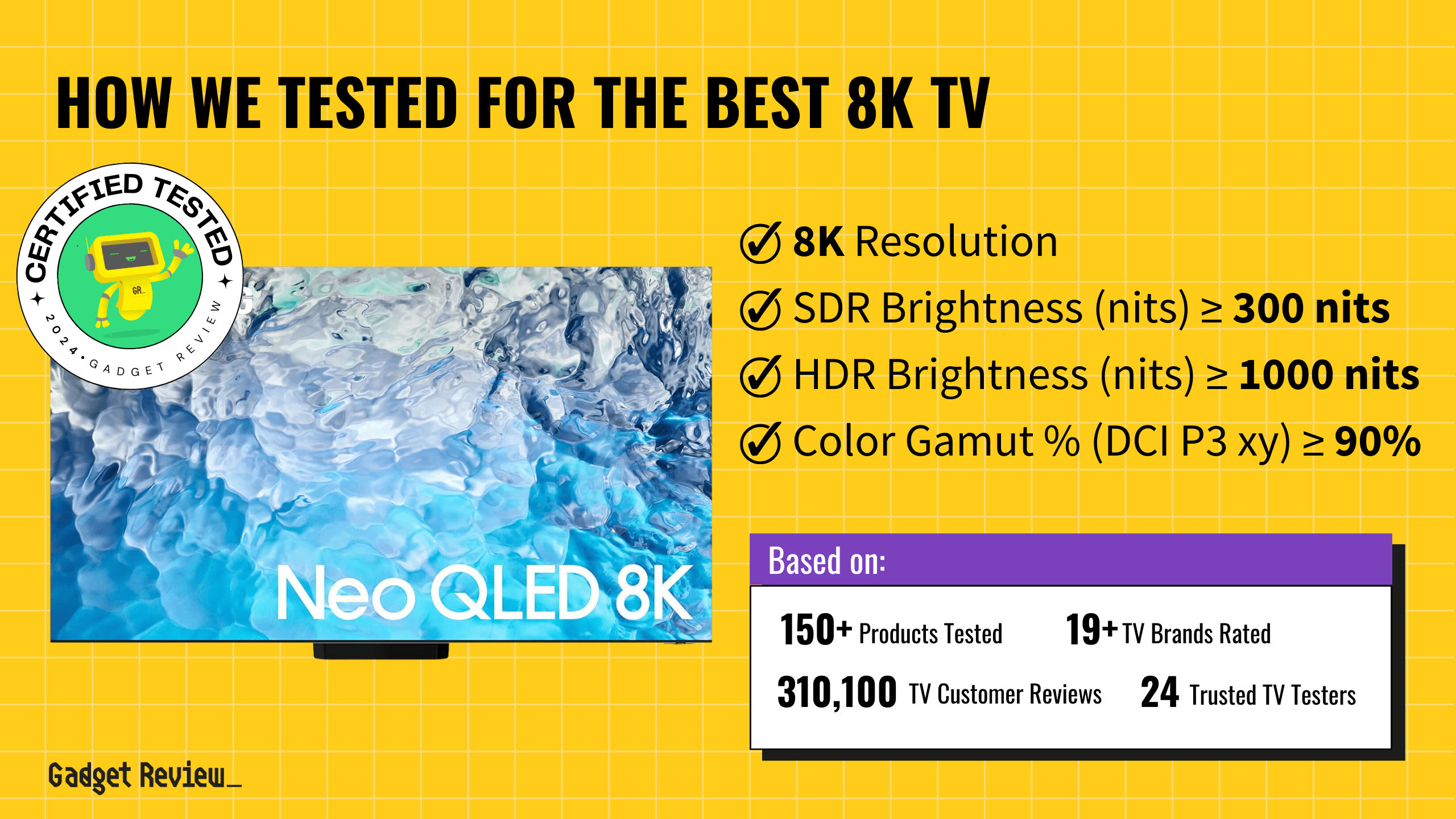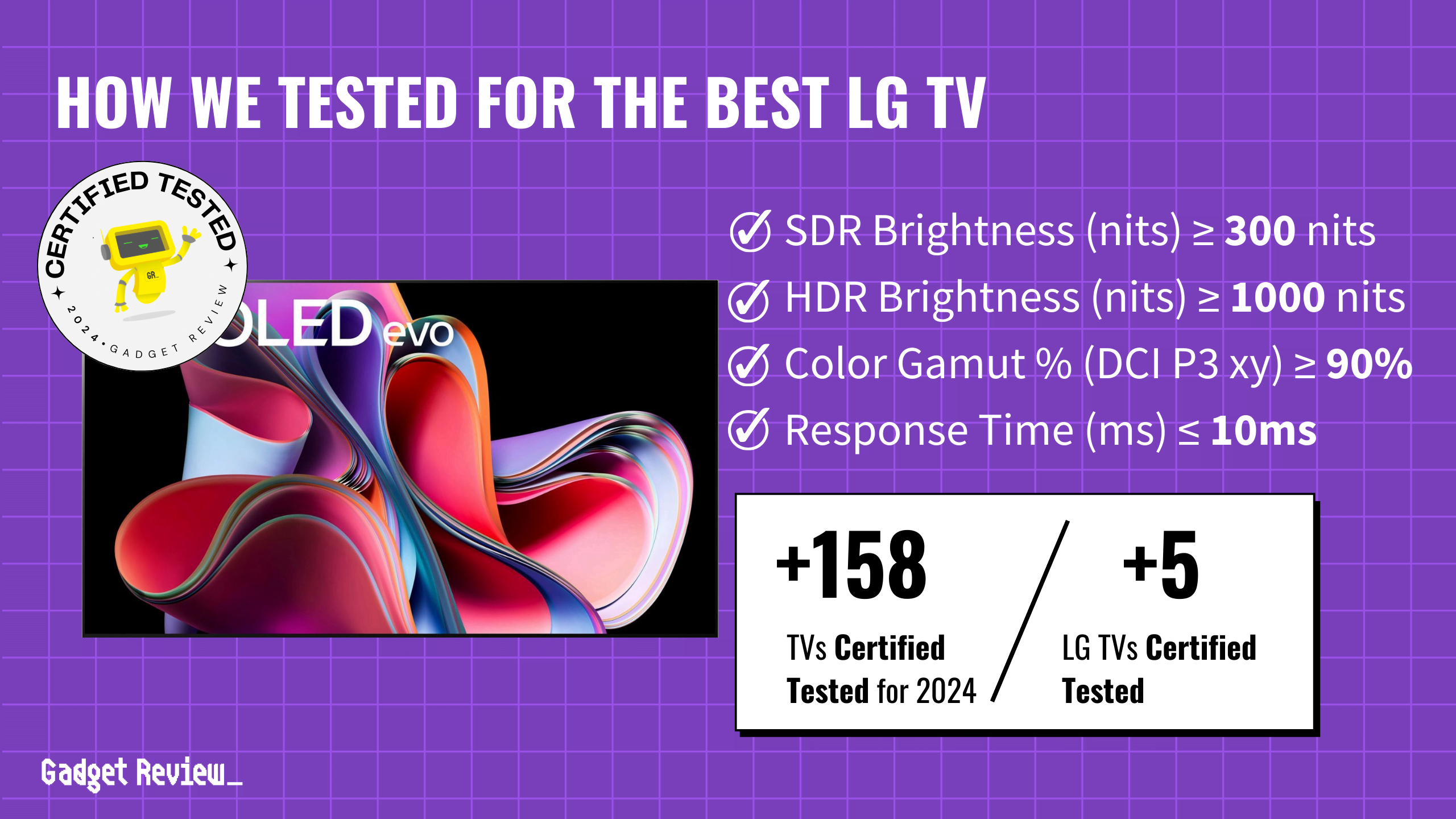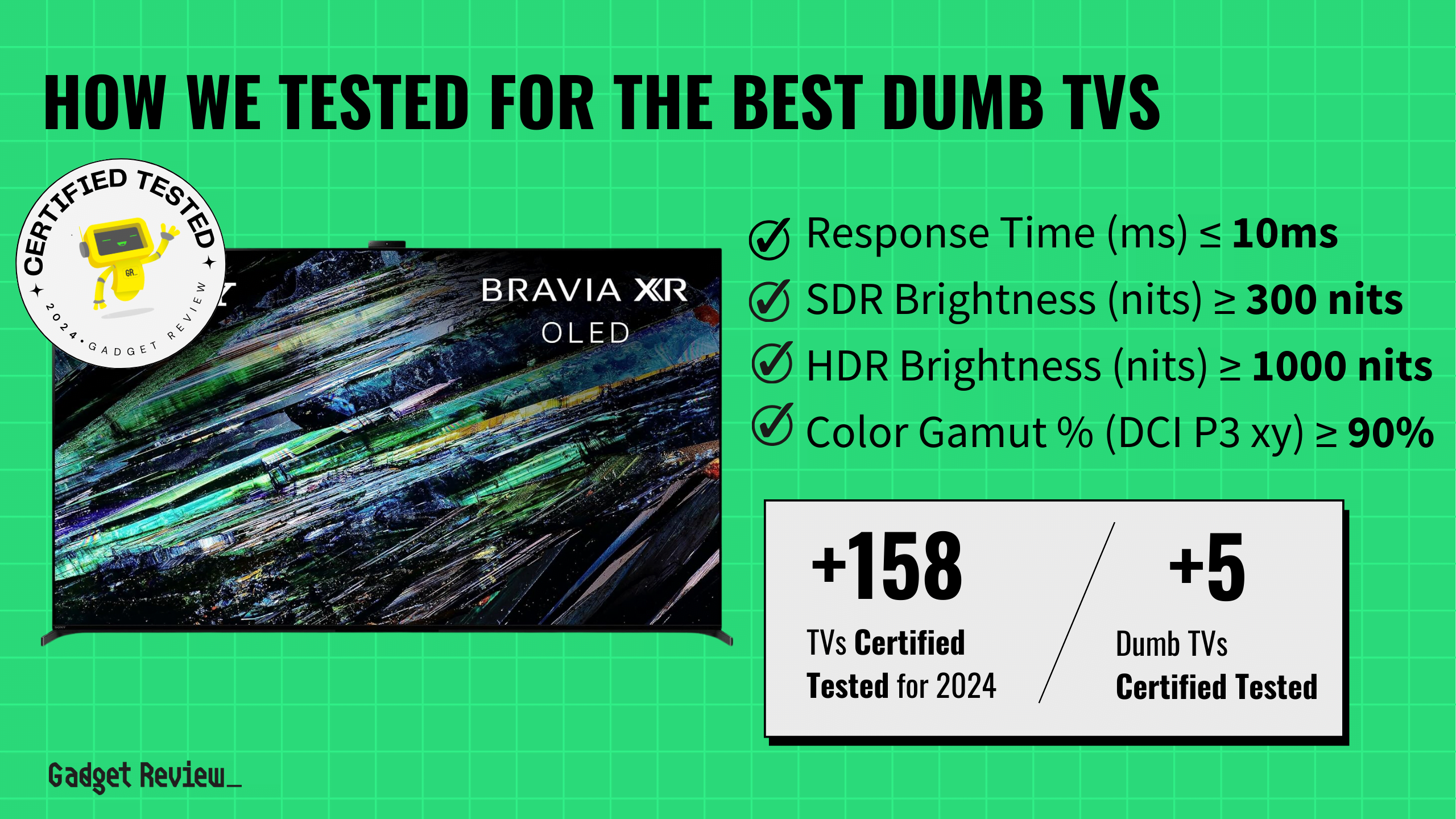When it comes to finding the best smart TVs, it’s crucial to navigate around the common pitfall of a sluggish operating system that can tarnish your viewing pleasure. A smart TV should offer a seamless interface, allowing you to switch between apps and streaming services without the dreaded lag or buffering. The ideal smart TV combines a robust OS with intuitive navigation and quick response times, ensuring your binge-watching sessions are smooth and uninterrupted.
Beyond just smart features, the best TVs bring together high-quality picture, with crisp resolution and vibrant colors, to complement their smart capabilities. While the market has a wide range of smart TVs, focusing on those with reliable, user-friendly platforms will elevate your entertainment experience, making every movie night or gaming session a delight.

TL;DR
When you shop through our links, you’re backing our mission.
🎨 Grab the Samsung S90C for unmatched color accuracy; best for true-to-life visuals.
🎬 Opt for LG B3 over Hisense U8K for a value cinematic experience; perfect for dark rooms.
☀️ Choose Hisense U8K over LG B3 for brighter rooms; best for sunny spaces.
💸 Definitely opt for Roku Plus Series for great quality at a low price; best for budget streaming setups.
How Did We Rank the Best Smart TVs?
To assess how high or low quality a smart TV actually is, one must evaluate specific testing criteria against reference industry standards. Using our thorough TV Testing Methodology, we determined there are 1 minimum specs and 6 criteria below (3 required, 3 nice to have) that ensure your Smart TV looks as good as the creator intended it.
?️ Minimum Specifications
- Smart Platform = Any Smart OS
? Test Criteria
- SDR Brightness: Must be ≥ 300 nits for a bright, clear picture in any light.
- HDR Brightness: Must be ≥ 1000 nits, bringing out the detail in high dynamic range content.
- Color Accuracy: Must cover ≥ 90% of the DCI P3 xy color space, ensuring vibrant colors.
? “Nice To Haves”
- Contrast Ratio: ≥ 10,000:1, for deep blacks and bright whites.
- EOTF Accuracy: Delta ≤ 0.018, ensuring precise brightness and contrast.
- Fast Response Time: ≤ 10ms, keeping the action smooth without blur.
We’ve redefined TV buying guides, setting us apart from any other site on the planet. Our unique approach combines in-house verification with a comprehensive dataset from over 200+ trusted sites, focusing on key testing metrics to rank the top rated smart TVs. Testing data and specs include brightness ≥ 300 nits for SDR, ≥ 1000 nits for HDR, color accuracy, and a set that is a Smart TV with Any Smart OS. In this case it’s for Smart TVs, catering to your need for advanced features and seamless connectivity. Discover our data-driven methodology for precise, reliable TV recommendations. Our commitment to unbiased reviews is powered by our ‘True Score’ system, targeting low quality and fake reviews. Commissions fund this mission. No bias. No BS.
Latest Updates
- 03/05/2024: Completely and thoroughly overhauled the guide to include the best and latest Smart TVs.
- 11/30/2023: Republished the list to include TVs based on our True Score system.
Top Smart TVs For 2025
Prices accurate at the time of publishing
To make it onto our list, a Smart TV must have an easy-to-use OS with impressive brightness and color accuracy. Anything falling short won’t make the cut!

Best Overall

Runner Up

Best Value

Best Budget

Best Mid-Range

Premium Pick
Samsung S90C TV
Best For Sports
The Samsung S90C delivers unparalleled color accuracy, superior brightness, and seamless Tizen OS integration, making it the ultimate choice for discerning viewers.
True Score
92948Experts
925kCustomers
Cosmic Wonder
 SAVE $500$1,499.99$999.99
SAVE $500$1,499.99$999.99Read More
Snapshot
Reasons to Buy
- Excellent picture quality
- The near-infinite contrast ratio for perfect blacks
- High peak brightness
- Exceptionally wide viewing angle
- Low input lag/Response time
- Sharp upscaling
Reasons to Avoid
- Aggressive Auto Brightness Limiter (ABL)
- No support for DTS or Dolby Vision
Specifications
Max Resolution 3840 x 2160 (4k) 
Backlight Type n/a Refresh Rate 120 Hz, 144 Hz Display Type OLED HDMI Inputs 4 
HDMI Type HDMI 2.1 HDR Format HDR10+, HLG 
HomeKit Compatible No 
Number of Audio Channels 2.1 
Panel Type OLED Screen size 55″, 65″, 75″, 83″ 
Smart Platform Tizen 
Speaker Output 40 Watts 
Sync Technology AMD FreeSync Premium 
VRR Yes All Specs
Test Results
SDR Brightness (nits) 373 HDR Brightness (nits) 1,058 Color Gamut % (DCI P3 xy) 99.975 Response Time (ms) 1.4 Contrast Ratio (x:1) 0 EOTF (600 nit delta) 0.0031 Color Gamut % (DCI P3 uv) 99.95 Color Gamut % (Rec 2020 xy) 86.37 Color Gamut % (Rec 2020 uv) 91.59 Color Gamut % (sRGB) 0 Color Gamut % (Rec 709) 0 Color Gamut % (BT.2020) 76 Color Gamut % (Adobe RGB) 0 Color Gamut % (BT.709) 0 Input Lag (ms) 8.5 Color Washout (Degrees) 70 Color Shift (Degrees) 70 Brightness Loss (Degrees) 70 Reflections (%) 1.2 Low-Freq Extension (Hz) 84.76 Freq Response StdDev @ 70db 2.8 Freq Response StdDev @ 80db 3.63 Weighted Total Harmonic Distortion @80db 0.133 Intermodulation Distortion @80db 2.47 EOTF (1000 nit delta) 0.0036 EOTF (4000 nit delta) 0.0024 All Tests
All Retailers
- $999.99$1,500Save $500
Availability
In StockFree Shipping
No - $1,387.92
Availability
In StockFree Shipping
No - $1,575.00$2,598Save $1,023
Availability
In StockFree Shipping
No
Our Verdict
The Samsung S90C TV earns one of the top spots on our Smart TV list thanks to its fantastic performance all-around, especially in color accuracy. With a best-in-class color gamut of 99.98% (DCI P3 xy) and the widest viewing of 70 degrees before colors start to wash out, the S90C delivers streaming content with colors that are as true-to-life as possible.
With an SDR brightness of 373 nits and an HDR brightness peak at 1058 nits, the Samsung S90C hits brightness levels high enough to make it an excellent option for dim and moderately lite rooms. However, as an OLED TV, it can’t compete with QLEDs for raw brightness output, so if you’re looking for a smart TV that can hold its own in rooms with tons of direct light, it isn’t the best choice.
The integration of Tizen OS provides a seamless and intuitive user interface for streaming and accessing a wide array of content. Its user-friendly design and support for a broad range of streaming services enhance the overall viewing experience, allowing users to easily navigate through their favorite shows and movies. The OS’s efficiency in handling applications and streaming content further complements the TV’s high performance in visual delivery.
If you love playing games as much as you love streaming, the S90C is an excellent choice for gaming and sports content, thanks to the outstanding input lag of 8.5ms and best-in-class response time of 1.4ms. With an infinite contrast ratio thanks to its OLED panel, the S90C can also deliver true blacks, which pairs perfectly with its best-in-class EOTF rating of 0.0031, giving it exceptional gamma performance.
Overall, the S90C excels in delivering the best of nearly all possible worlds. Between the well-received Tizen OS and the outstanding visual performance, the S90C is the perfect option for anyone looking for the best possible visual performance in all types of content, from streaming to HDR. While it may be pricey, and it may struggle in brightly lit rooms, the S90C can handle anything else you throw at it with grace.
Read Less

Best Overall

Runner Up

Best Value

Best Budget

Best Mid-Range

Premium Pick
LG B3 OLED TV
Offering OLED quality at an accessible price, the LG B3 provides excellent color fidelity, a simple user experience via WebOS, and versatile performance, ideal for both cinephiles and gamers alike.
True Score
89874Experts
921kCustomers
Absolutely Fresh
 SAVE $902$1,699.99$798.00
SAVE $902$1,699.99$798.00Read More
Snapshot
Reasons to Buy
- Excellent picture quality
- Great Contrast
- High-performance motion handling
- Fast refresh rate
- Wide Viewing Angles
Reasons to Avoid
- Below Average Brightness
- Aggressive ABL
- Mediocre speaker sound quality
Specifications
Max Resolution 3840 x 2160 (4k) 
Backlight Type n/a Refresh Rate 120 Hz Display Type OLED HDMI Inputs 4 
HDMI Type HDMI 2.1 HDR Format Dolby Vision 
HomeKit Compatible Yes 
Number of Audio Channels 2.1 
Panel Type OLED Screen size 55″, 65″, 77″ 
Smart Platform webOS 
Speaker Output 20 Watts 
Sync Technology AMD FreeSync Premium, G-Sync 
VRR Yes All Specs
Test Results
SDR Brightness (nits) 390 HDR Brightness (nits) 617 Color Gamut % (DCI P3 xy) 98.345 Response Time (ms) 3.1 Contrast Ratio (x:1) 0 EOTF (600 nit delta) 0.0067 Color Gamut % (DCI P3 uv) 99.62 Color Gamut % (Rec 2020 xy) 73.09 Color Gamut % (Rec 2020 uv) 77.66 Color Gamut % (sRGB) 0 Color Gamut % (Rec 709) 0 Color Gamut % (BT.2020) 73.14 Color Gamut % (Adobe RGB) 0 Color Gamut % (BT.709) 0 Input Lag (ms) 11.7 Color Washout (Degrees) 64 Color Shift (Degrees) 31 Brightness Loss (Degrees) 70 Reflections (%) 1.4 Low-Freq Extension (Hz) 84.76 Freq Response StdDev @ 70db 3.64 Freq Response StdDev @ 80db 3.67 Weighted Total Harmonic Distortion @80db 0.165 Intermodulation Distortion @80db 8.25 EOTF (1000 nit delta) 0.0035 EOTF (4000 nit delta) 0.0037 All Tests
All Retailers
- $798.00$1,700Save $902
Availability
In StockFree Shipping
Yes - $949.97$1,297Save $347
Availability
In StockFree Shipping
No - $1,196.99$1,697Save $500
Availability
In StockFree Shipping
- $1,199.99
Availability
In StockFree Shipping
No
Our Verdict
If you’re looking for a budget OLED, the LG B3 is an affordable (for an OLED, anyway) smart TVs with well-rounded performance, OLED features, and accessible price point. It boasts a remarkable color gamut of 98.35% (DCI P3 xy), ensuring that colors are reproduced with high fidelity, and its ability to maintain color integrity up to 64 degrees off-axis highlights the TV’s excellent viewing angle.
With SDR and HDR brightness levels at 390 nits and 617 nits respectively, the LG B3 OLED will struggle in bright rooms, especially compared to a QLED. It’s therefore best used in environments that are dimly lit or have moderate ambient light, like a dark home theater or game room.
The LG B3’s integration with the user-friendly and versatile WebOS provides a seamless and intuitive interface for accessing a wide range of streaming services. This ease of use enhances the overall user experience, allowing for effortless navigation and engagement with diverse content, from movies and TV shows to a plethora of applications designed to enrich the smart TV experience.
If you’re looking to do some gaming or want to stream sports, the LG B3 performs excellently for both. Its input lag of 11.7ms is quick enough for casual and light competitive games, and its 3.1 ms response time is fantastic for fast action with minimal blur. Like other OLEDs, the B3 features a near-infinite contrast ratio and its exceptional performance in gamma handling, with an EOTF rating of 0.0067, ensures that it delivers deep blacks and accurate mastering in any kind of content you can throw at it.
With its excellent price point and fantastic performance, the LG B3 is a great choice for anyone looking for a smart TV that will accurately render any kind of streaming content and can then switch effortlessly to gaming, sports or home theater content. Although it faces challenges in very bright environments, the LG B3 is the best way to get OLED performance and the webOS package without paying the usual OLED premium.
Read Less

Best Overall

Runner Up

Best Value

Best Budget

Best Mid-Range

Premium Pick
Hisense U8K TV
Best For Home Theater
With unmatched brightness and color accuracy, the Hisense U8K shines in well-lit spaces, providing a premium viewing experience without the premium price, especially for HDR enthusiasts.
True Score
82816Experts
851kCustomers
Absolutely Fresh
 SAVE $102$799.99$698.00
SAVE $102$799.99$698.00Read More
Snapshot
Reasons to Buy
- Good picture quality
- Outstanding brightness and good contrast ratio
- Quick response time
- Great reflection handling
Reasons to Avoid
- Poor viewing angles
Specifications
Max Resolution 3840 x 2160 (4k) 
Backlight Type Full-Array Refresh Rate 144 Hz 
Depth 3″ Display Type LED HDMI Inputs (Total) 4 
HDMI Type HDMI 2.1 HDR Format Dolby Vision, HDR10, HDR10+, HLG 
Height 33.1″ High Dynamic Range (HDR) Yes 
Number of Audio Channels 2.1.2 
Panel Type VA Screen size 100″, 55″, 65″, 75″, 85″ 
Smart Platform Google TV 
Speaker Output 50 Watts 
Voice Assistant Google Assistant 
Weight 56.4″ lbs 
Width 57.2″ 
Works With Google Assistant All Specs
Test Results
SDR Brightness (nits) 1,549 HDR Brightness (nits) 1,792 Color Gamut % (DCI P3 xy) 97.44 Response Time (ms) 13.3 Contrast Ratio (x:1) 165,360 EOTF (600 nit delta) 0.0105 Color Gamut % (DCI P3 uv) 97.01 Color Gamut % (Rec 2020 xy) 76.18 Color Gamut % (Rec 2020 uv) 81.82 Color Gamut % (sRGB) 0 Color Gamut % (Rec 709) 0 Color Gamut % (BT.2020) 80 Color Gamut % (Adobe RGB) 0 Color Gamut % (BT.709) 0 Input Lag (ms) 14.2 Color Washout (Degrees) 23 Color Shift (Degrees) 23 Brightness Loss (Degrees) 35 Reflections (%) 1.8 Low-Freq Extension (Hz) 80 Freq Response StdDev @ 70db 2.06 Freq Response StdDev @ 80db 2.11 Weighted Total Harmonic Distortion @80db 0.1 Intermodulation Distortion @80db 0.71 EOTF (1000 nit delta) 0.0106 EOTF (4000 nit delta) 0.011 All Tests
All Retailers
- $698.00$800Save $102
Availability
In StockFree Shipping
Yes - $799.99
Availability
In StockFree Shipping
No Availability
Free Shipping
Our Verdict
If you need bright room performance above all else, the Hisense U8K has you covered, delivering excellent performance at an exceptional price point. Featuring unparalleled brightness capabilities, with an SDR brightness of 1549 nits and an HDR brightness peaking at 1792 nits, the U8K is your ideal solution for brightly lit environments where glare and ambient light can often diminish viewing quality. Plus, with a color gamut of 97.44% (DCI P3 xy), it delivers rich and accurate colors suitable for a wide range of content, from intense action movies to vibrant nature documentaries.
Equipped with GoogleTV as well as Vidaa U, Hisense’s proprietary operating system, the U8K offers a straightforward and intuitive interface that caters to all your streaming needs. The OS facilitates easy access to a plethora of streaming services and apps, enhancing the user experience with its simplicity and speed, which complements the TV’s superior picture quality.
While the Hisense U8K may have a slightly higher input lag of 14.2ms and a response time of 13.3ms, making it slightly less ideal for competitive gaming, it still holds its own for casual gaming and watching fast-paced sports. Moreover, its exceptional contrast ratio of 165,360:1 ensures deep blacks and vivid contrast, perfect for HDR content where dynamic range is critical, though it can’t match the near-infinite contrast of OLEDs.
When brightness is the name of the game, Hisense’s U8K stands out, offering all the brightness you need for your well-lit rooms without compromising color accuracy. Along with its smart TV capabilities, it’s a strong contender for anyone looking to balance performance, streaming versatility, and value.
Read Less

Best Overall

Runner Up

Best Value

Best Budget

Best Mid-Range

Premium Pick
Roku Plus Series 4K QLED TV
Combining Roku’s intuitive streaming platform with respectable performance at an unbeatable price, the Roku Plus Series is the smart choice for budget-conscious streamers seeking quality.

True Score
80788Experts
852kCustomers
Absolutely Fresh
 SAVE $100$498.00$398.00
SAVE $100$498.00$398.00Read More
Snapshot
Reasons to Buy
- Outstanding Roku interface and remote
- Impressive HDR features
- Plethora of high-performance inputs
Reasons to Avoid
- Mediocre image quality
- Low peak brightness
- Mediocre motion handling and some motion blur
Specifications
Max Resolution 3840 x 2160 (4k) 
Backlight Type Full-Array Refresh Rate 60 Hz Display Type LED HDMI Inputs 4 HDR Format Dolby Vision, HDR10+, HLG 
LED Panel Type QLED Screen size 55″, 65″, 75″ 
Smart Platform Roku TV 
Sync Technology No 
VRR No All Specs
Test Results
SDR Brightness (nits) 537 HDR Brightness (nits) 576 Color Gamut % (DCI P3 xy) 95.9467 Response Time (ms) 10.5 Contrast Ratio (x:1) 42,750 EOTF (600 nit delta) 0.0064 Color Gamut % (DCI P3 uv) 0 Color Gamut % (Rec 2020 xy) 81.27 Color Gamut % (Rec 2020 uv) 0 Color Gamut % (sRGB) 0 Color Gamut % (Rec 709) 95.44 Color Gamut % (BT.2020) 81.3 Color Gamut % (Adobe RGB) 0 Color Gamut % (BT.709) 0 Input Lag (ms) 9.5 Color Washout (Degrees) 21 Color Shift (Degrees) 0 Brightness Loss (Degrees) 0 Reflections (%) 4.7 Low-Freq Extension (Hz) 0 Freq Response StdDev @ 70db 0 Freq Response StdDev @ 80db 0 Weighted Total Harmonic Distortion @80db 0 Intermodulation Distortion @80db 0 EOTF (1000 nit delta) 0.0063 EOTF (4000 nit delta) 0.0063 All Tests
All Retailers
- $398.00$498Save $100
Availability
In StockFree Shipping
Yes - $399.99$500Save $100
Availability
In StockFree Shipping
No
Our Verdict
If you’re looking for the least expensive way to get into streaming content without having to settle for bottom-of-the-barrel performance, the Roku Plus Series 4K QLED TV manages a respectable blend of performance, streaming capabilities and best-in-class value, offering up the greatest score and the lowest price. This TV boasts a commendable color gamut of 95.95% (DCI P3 xy), which, while not leading the pack, ensures that it delivers a broad spectrum of colors with good accuracy. This makes it suitable for a variety of content, from daily TV shows to animated films, where vibrant colors enhance the viewing experience.
The TV’s SDR and HDR brightness levels, at 537 nits and 576 nits respectively, keep the Roku Plus Series from performing well in brightly lit rooms, but it’s plenty capable for rooms with controlled lighting, like a dark home theater or dimly lit game room. It’s contrast ratio can’t compete with OLEDs, but as long as the TV stays in the surroundings it’s meant for, it’s more than enough to deliver dynamic content.
One of the Roku Plus Series’ most significant advantages is its integrated Roku TV platform, renowned for its user-friendly interface and extensive library of streaming services. This feature alone makes the TV a compelling choice for users who value convenience and the ability to access a wide array of content seamlessly. The Roku platform is celebrated for its simplicity, making it easy for users of all ages to navigate and find their preferred content, from the latest streaming apps to traditional broadcast channels.
If you want a TV that can pull double-duty, the Roku Plus Series is surprisingly competent for casual gaming. With an input lag of 9.5 ms and a response time of 10.5 ms, it’s not only capable of performing well in casual and competitive games, it also does a great job showing sports content with minimal motion blur.
When value is what matters most, the Roku Plus Series 4K QLED TV is the go to option for anyone looking for an affordable smart TV that does not compromise on essential features. Its performance in delivering a wide color spectrum, coupled with the intuitive Roku TV interface, makes it a valuable addition to any home.
Read Less

Our Approach to Testing Smart TVs
Evan Shepard/Gadget Review
We’ve redefined TV buying guides, setting us apart from any other site on the planet. Our unique approach combines in-house verification with a comprehensive dataset from trusted sites, focusing on key testing metrics like brightness (SDR and HDR), EOTF, response time, contrast ratio and color gamut.
When it comes to selecting the best smart TVs, it’s essential to avoid the frustration of sluggish operating systems that can detract from your viewing experience. A top-notch smart TV seamlessly integrates a responsive interface, enabling effortless navigation between apps and streaming services without delays or interruptions. Combining a robust OS with intuitive controls and swift response times ensures that your entertainment sessions remain smooth and enjoyable.
You may notice some of our graphs contain “Source: RTings”. This is to indicate that the data we’re showing off in a graph has come from a single source – because it’s the only source that actually tested the criteria and had data for it! Normally, our data is an average out of all of the various publications that test and provide data to give you a good idea of how a product is going to perform on average.
Which Criteria Matters for Testing Smart TVs?
By focusing on these criteria (3 required, 3 nice to have), anyone can quickly and easily compare these TVs and how they’ll perform. This helps you make an informed decision and purchase a TV that will fit into your small or tight space.
| CRITERIA | RANGE | REQUIRED | DEFINITION |
|---|---|---|---|
| SDR Brightness | 300+ nits | Yes | Assess the luminance of your display when operating in Standard Dynamic Range (SDR) mode. |
| HDR Brightness | 1000+ nits | Yes | Determine the luminance of your display in High Dynamic Range (HDR) mode. |
| Color Gamut (DCI P3 xy) | >= 90% | Yes | Evaluate the extent to which a TV can reproduce a specified spectrum of colors. |
| EOTF | 0.018 | No (nice to have) | Standard that governs how a display interprets and renders brightness and color. |
| Response Time | <=10ms | No (nice to have) | Time required for a pixel to transition from one color to another and then return to its original color. |
| Contrast Ratio | >= 10,000 | No (nice to have) | The ratio between the brightest white and darkest black that the screen can display. |
Our Trusted Data Sources
(Publication category Score is 80%+)
We looked at 210+ TV reviewers and while 24 are trustworthy (60%+ Trust Rating), we only use data from the testers that are “very trusted” which means a Trust Rating above 70%. The three we have listed below are our most trusted for TVs, along with our own in-house TV expert.
- Evan Shepard – Gadget Review
- Matthew Lopes – RTings, MuckRack
- Will Greenwald – PCMag, MuckRack, Twitter
- David Katzmaier – CNET, MuckRack, Twitter
Interested in a comprehensive analysis of our data sources? We’ve got you covered. Below, you’ll find a detailed list of every TV review website we’ve identified, organized by their respective Trust Ratings from highest to lowest. But we didn’t stop there. We’ve meticulously reviewed each publication and verified the data by checking whether the authors have bio links to MuckRack or LinkedIn. We’re committed to not only checking the facts but ensuring their veracity.
Smart TVs Test Data & Results
1. SDR & HDR Brightness TV Test Results
In well-lit rooms, the brightness level of your smart TV, quantified in nits, is key to a great viewing experience. A TV that doesn’t meet the brightness requirement will struggle against natural and artificial light, resulting in a dim, lackluster image. Essentially, nits measure how well your TV can stand up to light interference, with higher values ensuring a sharper, more vivid display.
For standard viewing on the best smart TV, you should look for at least 300 nits to strike the right balance between clarity and color quality in standard dynamic range (SDR) content. For high dynamic range (HDR) content, which offers richer colors and greater contrast, a minimum of 1000 nits is ideal to truly appreciate the enhanced visuals. These brightness levels are recommended to ensure your TV performs well in bright settings, allowing you to enjoy your shows and movies without any loss in detail or quality. Aim for these minimums: SDR Brightness >= 300 nits; HDR Brightness >= 1000 nits for the optimal experience.
Discover the top smart TVs, ranked from brightest to least.
Brightness
SDR: 300+ nits
HDR: 1000+ nits
Acceptable range of performance
Definition: Maximum brightness in a specified pattern size window. Most commonly measured in a 10% or 100% white window.
Units of Measurement: nits (alternatively cd/m²)
Tools to Measure: TV, luminance meter
Why It’s Important:
Brightness helps counter ambient light so that details and colors don’t wash out and get lost.
SDR Brightness (in nits, higher is better)
HDR Brightness (in nits, higher is better)
2. Color Gamut (DCI P3 xy) TV Test Results
Color Gamut
>= 90%
Acceptable range of performance
Definition: The TV’s capability to display a spectrum of colors.
Units of Measurement: % (color space coverage in percent)
Tools to Measure: Colorimeter
Why It’s Important:
Inaccurate colors compromise the authenticity of the content.
Color gamut defines the range of colors a smart TV can reproduce, directly affecting how vibrant and true-to-life the images look. A wide color gamut in a TV brings out richer, more vivid colors – from the lush greens of a garden to the bright colors of animated characters, enhancing your viewing experience to closely mimic real life.
This concept is technically measured against standards like the DCI P3 xy, a benchmark for high-quality visuals. A smart TV covering a higher percentage of this color space can display colors more accurately and vividly.
For those who prioritize vibrant and immersive visuals, aiming for a smart TV with a color gamut of 90% or higher on the DCI P3 xy scale is ideal. This ensures that the content you watch is as vibrant and lifelike as possible.
Below are the top smart TVs, ordered by color gamut, all exceeding our testing criteria.
DCI P3 XY Color Gamut (as a %; high is better)
3. EOTF Test Results
The Electro-Optical Transfer Function (EOTF) plays a critical role in ensuring the content on your TV looks exactly as the creator intended. This technical feature adjusts your screen’s brightness levels, ensuring every scene, from the darkest shadows to the brightest highlights, is displayed with true-to-life accuracy.
In rooms flooded with light, a TV that nails EOTF calibration shines by preserving the intended contrast and detail in the picture despite the challenging conditions. It balances the brightness so that images remain vibrant and full of detail, unaffected by the glare of ambient light.
A TV that excels in managing EOTF offers an immersive and authentic viewing experience. It brings creators’ visions to life, accurately rendering every scene with the proper light and dark levels, no matter the lighting in your room. This means you get a consistent, realistic picture that captures the full spectrum of colors and contrasts, from the subtlest hues to the most intense explosions.
Below are all the smart TVs on our list, ordered by EOTF, all exceeding our minimum requirement.
EOTF
< 0.018 (600 nit Δ)
Acceptable range of performance
Definition: How your TV interprets and renders the luminance data from content and translates it to be represented on screen. If EOTF/Gamma tracking is too low or too high, it will result in an over-brightened or over-darkened image from reference.
Units of Measurement: this test measures for the delta from the standard
Tools to Measure: Luminance colorimeter
Why It’s Important:
EOTF ensures that the game is displayed (color and HDR brightness) as the creator intended it
EOTF (source: rtings.com – 0 = no data exists; lower is better)
4. Response Time TV Test Results
Response Time
1ms-10ms
Acceptable range of performance
Definition: Speed at which a pixel transitions from one color to another
Units of Measurement: milliseconds (ms)
Tools to Measure: Screen, camera, test software
Why It’s Important:
A faster response time means less blur and thus more accuracy
A slow response time on a smart TV during fast-paced scenes is like trying to watch a thrilling movie with a foggy lens. Imagine settling in for an action-packed sequence, only to have the swift movements turn into a blur, robbing you of the crisp, clear detail you crave. This isn’t just a minor annoyance; it’s a major detriment to your viewing experience, leaving you with a picture marred by motion blur and visual artifacts.
So, what exactly is response time? It measures how quickly a pixel on your TV can change from one color to another. In the context of watching fast-moving content or enjoying dynamic scenes on a smart TV, a low response time is crucial. A response time of 15 ms or lower is good, but if you plan on gaming on this set, aim for a response time of 10 ms or lower. At these levels, your smart TV ensures smooth transitions and sharp visuals, making every scene come to life without any distracting blurs or delays.
Below are the top smart TVs, ordered by response time.
Response Time (in milliseconds; lower is better)
5. Contrast Ratio Test Results
For TV enthusiasts, a solid contrast ratio is crucial for enjoying your favorite TV shows or movies, especially in darker settings. This feature directly impacts how lifelike and dynamic the picture appears on your screen, ensuring that dark scenes are displayed with clear, crisp blacks instead of murky grays and bright scenes retain their detail without appearing washed out.
Put simply, the contrast ratio is all about the range of luminance a TV can produce, from the deepest blacks to the brightest whites. It’s what brings depth to the image, enhancing the realism of every scene. Watching a movie in the dark, for example, the difference between a TV with a poor contrast ratio and one with a high ratio is stark: the former struggles, blending shadows into a flat gray, while the latter delivers true black, making night scenes more immersive and detailed.
Ideally, a contrast ratio of 10,000:1 is what you should aim for in a smart TV. This level of luminance variance ensures that you’re getting a picture quality that can handle the nuances of lighting in any scene, providing a viewing experience that’s both rich and engaging. Note: OLED TVs have infinite contrast ratio, indicated by “0.”
Below are the top smart TVs, ordered by contrast ratio, all exceeding our testing criteria.
Contrast Ratio
>=10,000:1
Acceptable range of performance
Definition: Difference between the darkest black and the brightest white a screen can display.
Units of Measurement: cd/m2
Tools to Measure: Luminance meter
Why It’s Important:
A higher contrast ratio delivers deeper blacks, enhancing content definition, especially in darker rooms.
Contrast Ratio (higher is better)
Best Smart TVs: Mistakes To Avoid
- Overlooking Essential Features: Ignoring critical features such as screen resolution, refresh rate, and HDR compatibility can lead to dissatisfaction with the viewing experience. For instance, the best TV for seniors will emphasize ease of use, clear audio, and a user-friendly interface, which are crucial to enhancing their viewing pleasure and accommodating specific needs.
- Disregarding Long-Term Support: Failing to consider the manufacturer’s commitment to providing software updates and support for the smart TV’s operating system can result in outdated software and limited functionality over time.
- Ignoring Connectivity Options: Neglecting to assess connectivity options such as HDMI ports and Wi-Fi capabilities can hinder the smart TV’s ability to connect with other devices and access online content effectively. Moreover, using one of the best TV antennas that are compatible with your smart TV can enhance your access to local channels and content without relying solely on internet connectivity.
- Succumbing to Marketing Hype: Being swayed solely by flashy advertising or brand reputation without evaluating actual performance and user reviews can lead to purchasing a smart TV that doesn’t meet your expectations. To make an informed decision, you should understand what a smart TV is and its functionalities beyond the marketing claims.
The Best Smart TVs Tests Compared
Product |
True Score
|
SDR Brightness
|
HDR Barightness
|
Color Gamut
|
EOTF
|
Response Time
|
Contrast Ratio
| |
|---|---|---|---|---|---|---|---|---|
| 92 |
|
|
|
|
|
| $999.99 $1,500 $500 |
| 89 |
|
|
|
|
|
| $798.00 $1,700 $902 |
| 82 |
|
|
|
|
|
| $698.00 $800 $102 |
| 80 |
|
|
|
|
|
| $398.00 $498 $100 |

